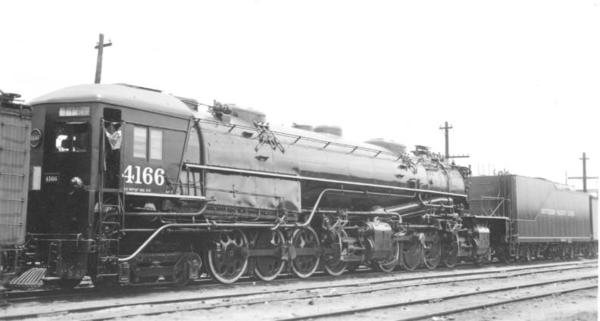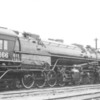I've always wondered how the Big Boys were delivered from Schenectady NY to the Union Pacific. I don't imagine the operated the water level route to Chicago or similar...
Replies sorted oldest to newest
bmoran4 posted:I've always wondered how the Big Boys were delivered from Schenectady NY to the Union Pacific. I don't imagine the operated the water level route to Chicago or similar...
No, new steam locomotives were towed dead, usually with a "rider" to insure proper lubrication enroute.
Hot Water posted:bmoran4 posted:I've always wondered how the Big Boys were delivered from Schenectady NY to the Union Pacific. I don't imagine the operated the water level route to Chicago or similar...
No, new steam locomotives were towed dead, usually with a "rider" to insure proper lubrication enroute.
I always wondered about that. Multiple people, (some with experience with steam) on other forums say that for the pistons to properly be lubricated, then the locomotive needs to be "hot" or at least have some steam pressure in the boiler. Is this not the case? Or were the piston rods not installed until delivery?
Thanks for your knowledge and continued patience.
hullmat991 posted:Hot Water posted:bmoran4 posted:I've always wondered how the Big Boys were delivered from Schenectady NY to the Union Pacific. I don't imagine the operated the water level route to Chicago or similar...
No, new steam locomotives were towed dead, usually with a "rider" to insure proper lubrication enroute.
I always wondered about that. Multiple people, (some with experience with steam) on other forums say that for the pistons to properly be lubricated, then the locomotive needs to be "hot" or at least have some steam pressure in the boiler. Is this not the case?
Yes, if the pistons are to be moving. However, new steam locomotives were shipped "dead in tow", with the main rods removed (usually wrapped/crated and loaded in/on the tender), thus neither the pistons nor the valves were moving.
Or were the piston rods not installed until delivery?
The pistons, piston rods, and crossheads were all installed, just the main rods were removed.
Thanks for your knowledge and continued patience.
Are there any known pictures or video of this occurrence?
bmoran4 posted:Are there any known pictures or video of this occurrence?
Pictures? Maybe, in one of the Kratville books. Videos? In 1941?????
Attachments
bmoran4 posted:Are there any known pictures or video of this occurrence?
I'm positive I saw a video depicting Baldwin shipping out new locomotives during the WWII war effort .. with some narration.
I'm having trouble finding it .... it may have been included in a larger WWII piece.
I found it interesting to runacross this after posting my question and reading the responses here:
No. 4000 was shipped dead via the Delaware & Hudson, New York Central, and Chicago & North Western to Council Bluffs, Iowa. A UP switch engine towed the engine across the Missouri River to Omaha Shops where it was officially accepted on Sept. 5, 1941. Later that month, No. 4000 was steamed up for the first time, and then put on display at Omaha Union Station. It traveled light to Council Bluffs for servicing, then back to Omaha to pick up a train of 100 empty Pacific Fruit Express reefers. The locomotive made several stops as it traveled west across Nebraska for water, fuel and crews, arriving in Cheyenne early the following day.
And while we're on the subject, does anyone know what roads & routes were used when 4018 was moved to Dallas for donation back in the 60's ?
I assume someone had to go oil around the rods and other moving surfaces along the way when on a delivery move?
Alemite guns were steam-operated, so I wonder how they packed the rods on a dead-in-tow locomotive?

The most famous dead move I can think of was the Prosperity Special, an epic 1922 delivery of twenty 2-10-2 locomotives, from Baldwin in Eddystone to the SP.
P51, I think those guns were pneumatic (air) operated. Never seen one steam operated, doesn't mean there wasn't any, I just never saw any.......!
p51 posted:I assume someone had to go oil around the rods and other moving surfaces along the way when on a delivery move?
Yes, a "rider" generally from the builder, accompanied the locomotive/locomotives.
Alemite guns were steam-operated, so I wonder how they packed the rods on a dead-in-tow locomotive?
Nope, the Alemite guns were/are air operated, off main reservoir air pressure, just as they are today. Applying steam to such a device would have burned out all the gaskets/seals, not to mention making the gun WAY too hot to handle, which would also melt the pin dope (grease) before it ever was forced into the rod bearings.
Brandy posted:P51, I think those guns were pneumatic (air) operated. Never seen one steam operated, doesn't mean there wasn't any, I just never saw any.......!
Never watched one being used close up. Makes sense to run it off the main air line when stopped. Does this mean that beyond the lead (hot) locomotive on a dead-in-tow move, would they run it off the brake line to pack the rods every now and then when stopped?
p51 posted:Brandy posted:P51, I think those guns were pneumatic (air) operated. Never seen one steam operated, doesn't mean there wasn't any, I just never saw any.......!
Never watched one being used close up. Makes sense to run it off the main air line when stopped. Does this mean that beyond the lead (hot) locomotive on a dead-in-tow move, would they run it off the brake line to pack the rods every now and then when stopped?
Yes, since all the main reservoirs would have air pressure from the train line brake pipe, just like a boxcar.






